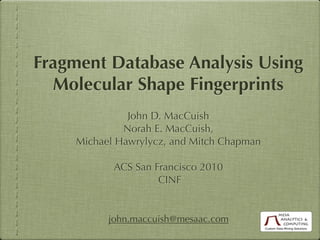
Molecular Shape Fingerprints and Fragment Analysis
- 1. Fragment Database Analysis Using Molecular Shape Fingerprints John D. MacCuish Norah E. MacCuish, Michael Hawrylycz, and Mitch Chapman ACS San Francisco 2010 CINF john.maccuish@mesaac.com
- 2. Outline • Shape Fingerprints:quasi-Monte Carlo integration approach • 2D substructure commonality • 3D shape and pharmacophore features analogue • Fragment Database Example • Future Work
- 3. quasi-Monte Carlo Integration (QMC)* • Approximate a 3D volume -- e.g., CPK van der Waals • In practice, quasi-randomly generated points have best error convergence in low dimensions. • Align volumes using binomial sampling = shape fingerprints, and SVD • Fast and accurate *”Quasi-Monte Carlo integration for the fast and effective generation of molecular shape fingerprints”, ACS San Francisco, Wednesday 2:30 , COMP 346
- 5. Four subfingerprints Find maximum alignment to other fingerprints of confirmations similarly sampled Maximum Tanimoto for best alignment
- 6. 2D Substructure Commonality • Exploratory visualization tool on a series or a 2D cluster of structures. • Akin to loosening the constraint on a maximal common substructure (MCS). • Path based 2D fingerprint form: “Stigmata”* • Key-based 2D fingerprint form “ChemTattoo” *"Stigmata: An Algorithm To Determine Structural Commonalities in Diverse Datasets", Shemetulskis, et al, JCIM, 36(4),1996, pp. 862-871
- 7. 2D Substructure Commonality 2D 768 Key-based Fingerprint "Substructure commonality analysis and visualization with new key-based binary fingerprinter", Norah MacCuish, ACS Chicago, CINF Session, March 24-28, 2007.
- 8. 2D ChemTattoo • Generate the modal fingerprint from the input data set • Modal fingerprint is the same length as the input data set 2D fingerprints • A bit is set in the Modal if that ‘key’ occurs at least in the threshold number of input molecules • Compare each input 2D fingerprint against the Modal Fingerprint • Calculate atom score (counts) for each atom for each input structure that reflects the number of modal keys that a given atom participates in. Color code the scores and depict the 2D structures.
- 9. 2D ChemTattoo Four 2D fingerprints Threshold set to 1.0 -- no bit in common among all 4 fingerprints Threshold set to 0.5 -- some bits in common among all 4 fingerprints
- 10. 2D ChemTattoo PUT CHEMVC EX OUTPUT HERE
- 11. Pharmacophore Extension • Adding a pharmacophore extension to quasi- Monte Carlo generated shape fingerprints. • Substructure matching with pharmacophore features with user defined SMARTS • Create a ChemTattoo analogue in 3D, map the features onto the shape fingerprint. • Apply to 3D shape clusters, similarity searching, etc.
- 12. ChemTattoo 3D • Allow the pharmacophore features to included standard definitions (HBond donor, HBond acceptor, etc. Or allow a user defined set of definitions -- SMARTS based) • Perform shape fingerprint clustering and analyze the resulting clusters to perceive patterns (modal) in the pharmacophore feature space • Use a known target as the modal and query a database to find similar shape (based on shape fingerprints) and align the shape hits based on the pharmacophore features of the target. • Apply these ideas to fragments to find potential bioisosteres for an active fragment found from a fragment screen
- 13. Fragment Database • ZINC Fragment database, ~500K compounds • Cluster in 2D using 768 MACCS Keys Fingerprints • Select the Representatives to create a 2D diverse set • Generate multi-conformations (< 5Kcals) and Shape Fingerprints for all conformers • Shape Fragment Database contains: 3,265 structures, 24,029 conformers
- 14. Bacterial 23S rRNA Fragment Screen 1. Generate conformers for the active fragment 2. Search Fragment Database w/ Shape FP cutoff: 0.6 - 324 conformers share the same shape 3. Identify the Pharmacophore Features in Target (features can be user defined) Kd > 100µM 4. Score the Fragment 3D database based on the MS number of modal pharmacophore features for fragments within the shape cutoff (require at least two pharmacophore matches) 5. Display the highlighted pharmacophore features in the target with a surface overlay 6. Align the hits via shape -- slider bars display shape matches that also have matching features within the slider bar distance Nature Reviews Drug Discovery v.3 8/04, p. 669
- 15. Bacterial 23S rRNA • Pharmacophore features of Active fragment • Shape of Active fragment w/ features highlighted • Hitlist of one conformation of Active fragment with highest scoring matches • Shapes aligned for the best shape fingerprint score
- 16. Bacterial 23S rRNA Showing hitlist... User to move the slider bar on the ‘red’ HBond Acceptor and find the shape matched fragment that also has a HBond Acceptor ‘close’ in distance space to the target.
- 17. Future Work • Adding in Thresholding • More experiments in industrial settings • Expanding the pharmacophore default feature definitions • Better visualization tools
- 18. Acknowledgments • Open Source • Mesa Software • JMol • ChemTattoo 2D, 3D • Balloon • Shape Fingerprint • OpenBabel Module • BKChem • Fingerprint Module 2D • Databases • Parallel Grouping Module • ZINC • PDB • WebflowDD john.maccuish@mesaac.com
